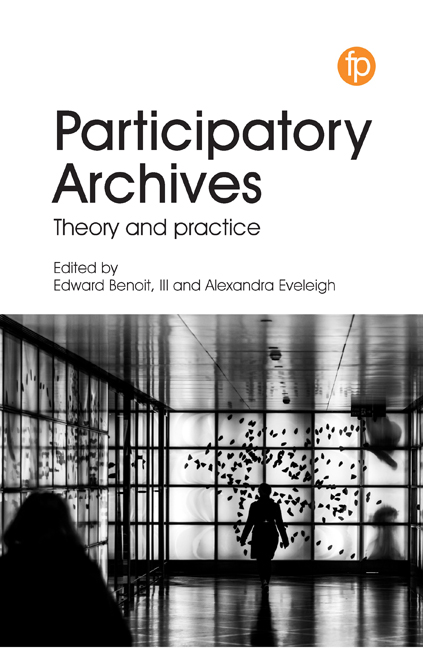Book contents
- Frontmatter
- Contents
- Figures and table
- Notes on contributors
- 1 Defining and framing participatory archives in archival science
- SECTION 1 SOCIAL TAGGING AND COMMENTING
- 2 Social tagging and commenting in participatory archives: a critical literature review
- 3 Social tagging and commenting: theoretical perspectives
- 4 Project Naming: reconnecting indigenous communities with their histories through archival photographs
- 5 (Hash)tagging with the users: participatory collection of digital social photography in museums and archives
- SECTION 2 TRANSCRIPTION
- SECTION 3 CROWDFUNDING AND OUTREACH
- SECTION 4 ALTERNATIVE AND ACTIVIST COMMUNITIES
- Notes
- Index
2 - Social tagging and commenting in participatory archives: a critical literature review
from SECTION 1 - SOCIAL TAGGING AND COMMENTING
Published online by Cambridge University Press: 25 October 2019
- Frontmatter
- Contents
- Figures and table
- Notes on contributors
- 1 Defining and framing participatory archives in archival science
- SECTION 1 SOCIAL TAGGING AND COMMENTING
- 2 Social tagging and commenting in participatory archives: a critical literature review
- 3 Social tagging and commenting: theoretical perspectives
- 4 Project Naming: reconnecting indigenous communities with their histories through archival photographs
- 5 (Hash)tagging with the users: participatory collection of digital social photography in museums and archives
- SECTION 2 TRANSCRIPTION
- SECTION 3 CROWDFUNDING AND OUTREACH
- SECTION 4 ALTERNATIVE AND ACTIVIST COMMUNITIES
- Notes
- Index
Summary
What if you could contribute your own description of a certain photo in … the Library of Congress’ vast photographic archive, knowing that it might make the photo you've touched a little easier to find for the next person? Well … you can.
George OatesIntroduction
Participatory archiving hinges on the ‘sharing of authority and control/curation between the archivist and a body of users who self-identify as stakeholders in the archives’ content’. Participatory archiving received a terrific boost from the emergence of Web 2.0, which ‘embraces collective intelligence and participation, and affords previously passive recipients of content the opportunity to engage with, combine, share, and “mash up” information in new and imaginative ways’. With the advent of Web 2.0 and social tagging applications such as Flickr and del.icio.us in late 2003, archivists and other information professionals saw an opportunity to engage the public actively in knowledge creation. The ‘wisdom of the crowd’ became an article of faith for many Web 2.0 proponents affiliated with galleries, libraries, archives and museums (GLAMs).
Archives 2.0 introduced the possibility of the archive as a participatory platform as well as a physical space. By engaging with and potentially contributing to the archives, users helped define its very meaning. (Archives 2.0's admirers positioned it as open, transparent, collaborative, experimental, user-centred, technology-oriented, iterative, innovative, flexible, and proactive regarding outreach.) It allowed laypersons to be archivists – to create and describe their collections as well as to refer to others’ collections.
Though archivists (and museum professionals) seemed relatively slow adopters of these technologies, beginning in the mid-2000s a number of participatory archiving initiatives solicited the contributions of diverse audiences to enhance records’ descriptions or metadata. Democratising archival decision making seemed a ‘golden opportunity’ for GLAMs to drum up new stakeholders.
Despite hopes of a ready-made ‘virtual volunteer corps’, however, it remains difficult to integrate user contributions into repositories’ descriptive workflows. An increasing number of archivists exploit social media to publicise collections and the institution, but the potential of social tagging and commenting is far from fulfilled. In 2009, Trant asserted, ‘We still need to know more about why people tag, whether taggers’ motivations differ in different circumstances, and how people might be encouraged to tag or tag “well”.’ Her point remains valid in early 2018: much information on Web 2.0 users is speculative, anecdotal or founded on sample populations that resist comparison.
- Type
- Chapter
- Information
- Participatory Archives , pp. 15 - 32Publisher: FacetPrint publication year: 2019
- 2
- Cited by



